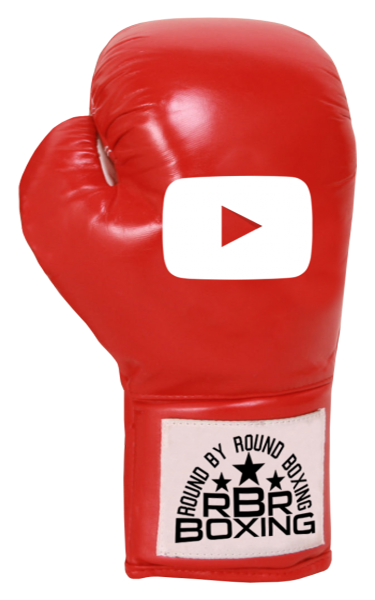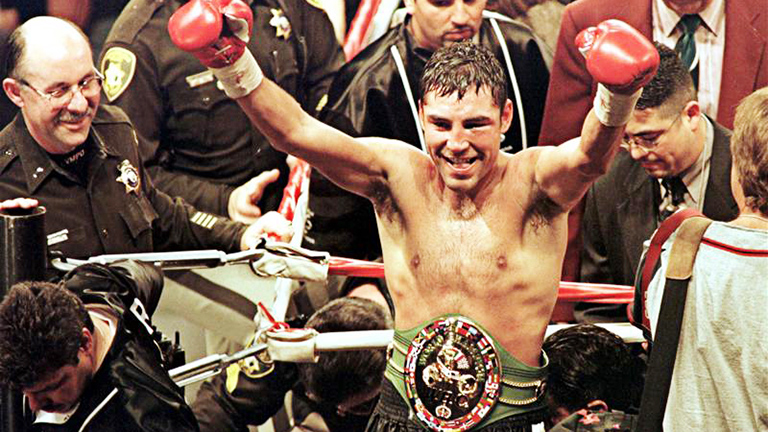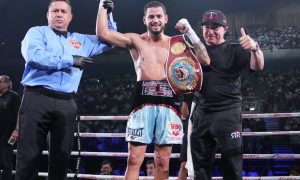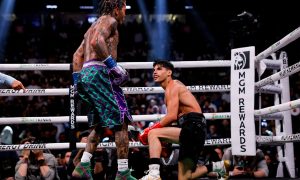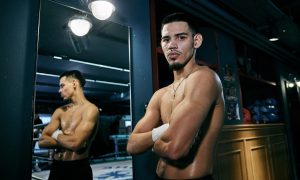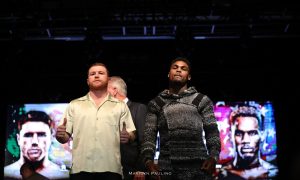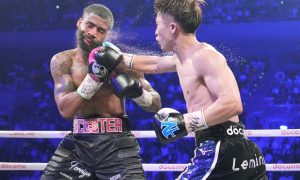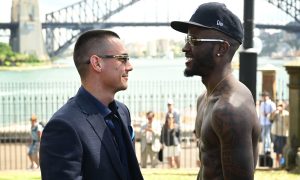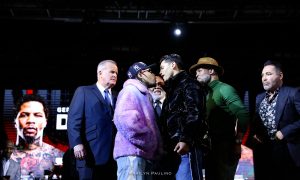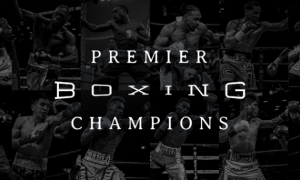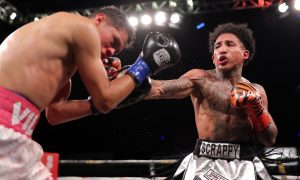Almost 12-years ago, in December 2008, boxing fans witnessed Oscar De La Hoya (39-6, 30 KOs) sit on his stool after eight one-sided rounds against Manny Pacquiao and pull the plug on the fight and his career.
In retrospect, there is no shame in having your final fight be against a fellow legend like Pacquiao in what turned out to be a pseudo passing of the torch moment in the sport.
However, playing the role of the stepping-stone to launch someone else’s rise to the top may not have sat well with the Golden Boy after all these years.
Last week, De La Hoya confirmed rumors that at 47 years of age, he plans to make a return to the squared circle.
“The rumors are true, and I’m going to start sparring in the next few weeks,” stated De La Hoya to ESPN. “It’s a real fight. I miss being in the ring, I love boxing. Boxing is what gave me everything I have today, and I just miss it.”
What makes De La Hoya’s potential return somewhat surprising is that it won’t be for monetary reasons.
De La Hoya is the CEO of Golden Boy Promotions, which promotes boxing’s most prolific superstar Saul “Canelo” Alvarez. The promotional company also promotes two of boxing’s most highly touted up and coming stars in Welterweight Vergil Ortiz Jr. and Lightweight Ryan Garcia.
A comeback for a fighter that has already had his name enshrined in the boxing Hall-of-Fame is about passion and possibly the belief that he can still compete with today’s fighters.
“These guys are in it just for the money—that’ll be the difference,” said De La Hoya to ESPN. “I will fight for the glory, and these guys only fight for the money. And guess what? The glory will always win.”
Having competed as a professional boxer from 1992 to 2008 and winning 11 world titles over six weight classes, De La Hoya is not going to look anywhere near his peak in a return.
However, due to scandals with drug and alcohol addiction and his public dealings as a promoter, fans may have forgotten just how good De La Hoya was at his best.
Reflecting on his career, we will take a look back at five of De La Hoya’s best performances.
RAFAEL RUELAS (53-4, 41 KOs) – SECOND ROUND TKO
IBF and WBO LIGHTWEIGHT TITLES – MAY 6, 1995
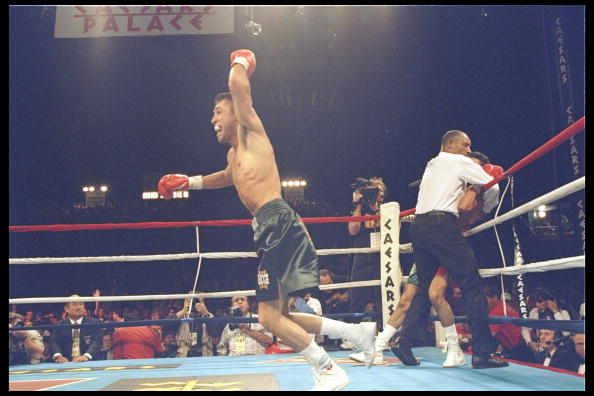
The year 1995 was a significant year for the Hall-of-Famer as he proved himself to be one of the top fighters in the world.
De La Hoya fought four times against top competition earning the Ring Magazine and Boxing Writer’s Association of America’s Fighter of the Year award.
The victory that solidified the 1992 Olympic gold medalist was against IBF Lightweight champion Rafael Ruelas.
The fight against Ruelas was De La Hoya’s first headlining pay-per-view (PPV) and would prove to be the beginning of a long line of pay-per-view events.
De La Hoya entered the match, holding the WBO Lightweight title attempting to make the fourth defense of his title and unify with Ruela’s IBF Lightweight title.
The two pugilists had some personal issues due to differing stories about how sparring sessions went between them.
In life, just like in boxing, sometimes it’s more about how you do something versus what you do.
In De La Hoya’s case, he made quick work of Ruelas by using his jab and usually being first to attack. After being dominated in the first round, Ruelas decided to be the aggressor.
The decision to become the aggressor led him into De La Hoya’s left hook that sent him down to the canvas twice. After the second knockdown, referee Richard Steele put a stop to the fight.
The match with Ruelas showcased De La Hoya’s power, but also his willingness to attack and be aggressive on the biggest stage of his career up to that point.
MIGUEL ANGEL GONZALEZ (51-5-1, 40 KOs) – UNANIMOUS DECISION
WBC SUPER LIGHTWEIGHT TITLE – JANUARY 18, 1997
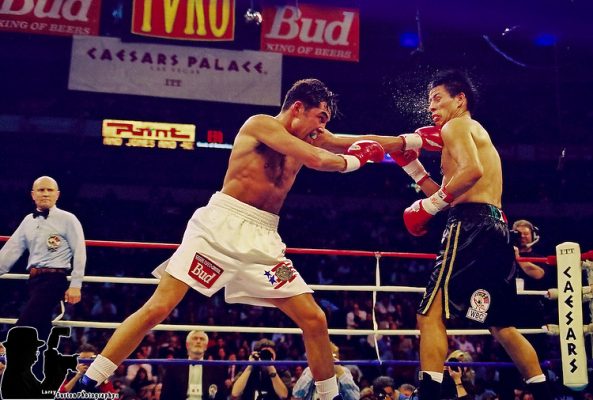
One of De La Hoya’s most underrated performances came in the year 1997, where the Golden Boy would step inside the squared circle an unprecedented five times.
In between bouts with all-time greats Julio Cesar Chavez Sr. and Pernell Whitaker, De La Hoya defended his WBC Super Lightweight title against Miguel Angel Gonzalez.
At the time, the eccentric Jesus Rivero was training De La Hoya. Rivero was best known for training Flyweight champion Miguel Canto in the 1970s.
Rivero was a trainer that focused more on the mental than physical as he had De La Hoya read Shakespeare, listen to classical music, and read about history and politics.
“I can teach him,” Rivero stated to the Los Angeles Times in 1996. “He’s going to discover a world he doesn’t know. I want to work with his mind, not only boxing. I don’t want to make him a killer, I want to make him a human being.”
Against Gonzalez, De La Hoya arguably put on his best boxing performance. De La Hoya’s left jab was consistent throughout the entire fight while using lateral movement to maintain a proper distance.
The then three-division champion would win a wide unanimous decision with scores of 117-111, 117-110, and 117-109.
The performance wasn’t perfect as it showcased just how left hand dominant De La Hoya was at the time. The right hand wouldn’t fully develop until Floyd Mayweather Sr. trained him later in his career.
De La Hoya’s time at Super Lightweight was short at just three fights; however, his performances in the weight class are some of his best. If he had stayed at Super Lightweight, it might have turned out to be the division he was at his most dangerous.
IKE QUARTEY (37-4-1, 32 KOs) – SPLIT DECISION
WBC WELTERWEIGHT CHAMPIONSHIP – FEBRUARY 13, 1999
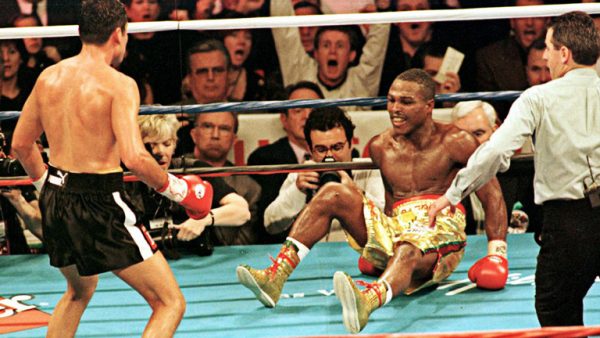
In 1999, De La Hoya had two fights that were promoted as his era’s Ray Leonard-Thomas Hearns. The Golden Boy in 1999 faced off against Ike Quartey, Oba Carr, and Felix Trinidad coming away with victories in two of the three bouts.
More than 20 years later, it seems impossible for someone like current WBO Welterweight champion Terence Crawford facing Errol Spence Jr., Shawn Porter, and Danny Garcia in the same year.
The most memorable fight for De La Hoya in 1999 was against Quartey, who hailed from Accra, Ghana.
Quartey was a former WBA Welterweight champion and had been out of the ring since October 1997 when he faced De La Hoya in February 1999. The Ghanaian champion was stripped of his title in 1998.
De La Hoya would be making the sixth defense of his WBC Welterweight title and previously stopping Julio Cesar Chavez Sr. in a highly anticipated rematch.
While Quartey would be fighting after more than a year out of the ring, the bout with De La Hoya would turn out to be one of the best of the year.
Quartey was best known for having one of the best jabs in all of the sport. Both men would trade jabs throughout the fight as the first half of the bout played out like an exciting chess match.
In the sixth round, the match took a dramatic turn with both men scoring knockdowns with left hooks. De La Hoya struck first in dropping Quartey and attempted to finish the fight by cornering the Ghanaian and unleashing combinations.
Quartey was calm under the fire and waited until De La Hoya punched himself out and scored a knockdown of his own with a short left hook that did more damage than it looked.
The former WBA Welterweight champion would take advantage of the proceeding rounds, as De La Hoya seemed hesitant to attack as the fight progressed.
Although they were many close rounds that could have been scored for either man, Quartey seemed to be winning the battle of the jabs.
The fight was hanging in the balance in the championship rounds, and De La Hoya needed something dramatic to secure a victory.
In the 12th round, De La Hoya landed a left hook that dropped Quartey. De La Hoya once again cornered Quartey and unloaded a barrage of punches on the Ghanaian.
Quartey showed tremendous heart by not getting dropped again and was lucky that referee Mitch Halpen didn’t put a halt to the bout.
De La Hoya punched himself out, and both men ended the round staring at each other instead of punching, as they were both exhausted.
The judges came back with a split decision in favor of De La Hoya with scores of 116-112, 116-113, and one card for Quartey at 115-114.
The late Harold Lederman, who scored the fight for HBO, had the fight for Quartey with a score of 114-113.
Despite the fight being an exciting fight that was successful on PPV having made 570,000 buys, a rematch never came to fruition.
Whether you had De La Hoya winning or not, the fight with Quartey showed his willingness to take on the best opponents in his division and an ability to perform under tremendous pressure. De La Hoya proved to be clutch in the championship rounds.
FERNANDO VARGAS (26-5, 22 KOs) – TKO11
WBC AND WBA SUPER WELTERWEIGHT TITLES – SEPTEMBER 14, 2002
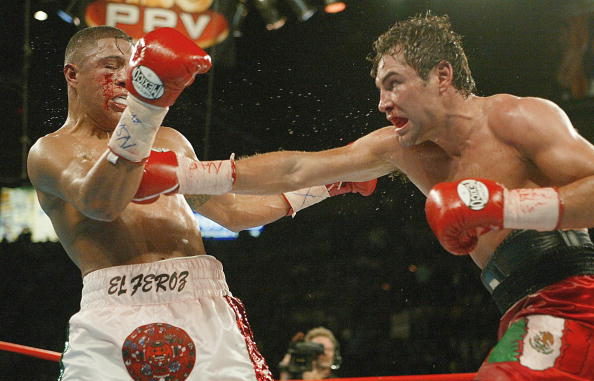
Sometimes the most satisfying victories are ones that are personal.
The fight that was promoted as “Bad Blood” would turn out to be one of De La Hoya’s most challenging fights and best overall performances.
The “Bad Blood” between De La Hoya and Fernando Vargas stemmed from an incident in Big Bear, California, early in both men’s careers. Vargas contends that while on a run he tripped and fell on a snowy path as the Golden Boy ran past him laughing at his expense.
From that point forward, Vargas would hold a personal grudge towards De La Hoya.
The bout was initially scheduled to take place in May 2002; however, it was postponed to September due to De La Hoya suffering a hand injury in training camp.
At the time, Floyd Mayweather Sr. was training De La Hoya, and in many respects, this turned out to be the difference in the fight.
Vargas in previous fights showed his ability to box, but against De La Hoya, he chose to be the aggressor from the start. In the first round, Vargas got De La Hoya against the ropes and unloaded a series of punches that seemed to hurt the 1992 Olympic gold medalist.
The first half of the fight would follow a pattern as both men traded winning rounds. Anytime Vargas got De La Hoya against the ropes on his back foot, he held an advantage.
De La Hoya would find more success boxing Vargas in the middle of the ring.
By the seventh round, De La Hoya began utilizing his right hand and landing the punch consistently. Vargas would continue applying pressure but became less effective as the rounds went by.
At the end of the 10th round, De La Hoya landed a beautiful combination that started with body punches and ended with a left hook up top that visibly wobbled Vargas.
The end came in the 11th when De La Hoya landed a left hook that dropped Vargas. When Vargas got up from the knockdown, he was met with a barrage of punches from De La Hoya, forcing referee Joe Cortez to stop the bout.
De La Hoya-Vargas was one of De La Hoya’s highest-selling PPV’s almost hitting a million sales at 935,000 buys.
After the bout, it was found that Vargas tested positive for anabolic steroids for which he was fined and suspended.
A rematch was talked about between the two Mexican-Americans; however, it never came to be despite the financial success of the first encounter.
RICARDO MAYORGA (32-12-1, 26 KOs) – TKO6
WBC SUPER WELTERWEIGHT TITLE – May 6, 2006
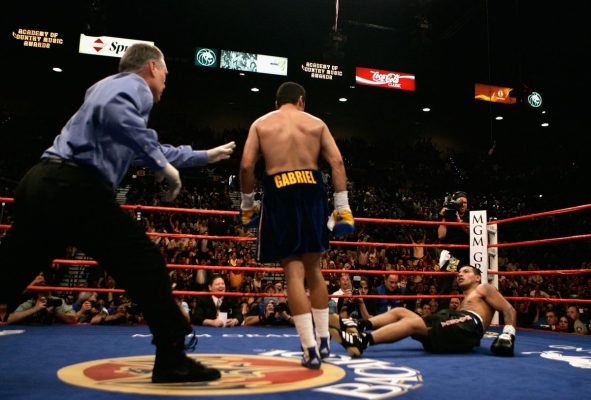
There were questions surrounding De La Hoya before his bout with Nicaragua’s Ricardo Mayorga in 2006.
After a 20-month hiatus and the first knockout loss of his career against Middleweight kingpin Bernard Hopkins in September 2004, fans pondered if De La Hoya still had the desire to fight.
Now a six-division world champion, De La Hoya’s path to the Hall-of-Fame, was paved in stone. However, Mayorga’s pre-fight trash talk was enough to invigorate the Golden Boy.
Mayorga is the perfect opponent to return against as he can help build the fight’s promotion and is tough enough to create a memorable night of boxing.
Felix Trinidad used Mayorga as an opponent when he returned after more than two years out of the ring in October 2004. De La Hoya would do the same and more.
The first round set the tone for the remainder of the fight when De La Hoya landed a perfect left hook during an exchange and stared down at the loquacious Mayorga while he sat on the canvas.
Mayorga would have his moments specifically in the third round when he landed a clean uppercut from the outside on De La Hoya; however, the majority of the bout was a display of execution from the Golden Boy.
De La Hoya did what he wanted whenever he wanted against Mayorga. In the sixth round, the fight came to an end when he dropped Mayorga twice with referee Jay Nady mercifully putting the fight to an end.
The Mayorga victory was a return to form for De La Hoya and a confidence booster that showcased he was still able to compete at an elite level.
De La Hoya would win the WBC Super Welterweight title against Mayorga and would be the final title victory of his career.
The Mexican-American superstar is a fighter that was caught between two generations. He came at the tail end of the careers of Whitaker and Chavez and was the catalyst to springboard the careers of Floyd Mayweather Jr. and Manny Pacquiao.
Fans today may not realize just how good De La Hoya was in his prime and, more importantly, how often he took on the best fighters available.
Similar to actor Antonio Banderas who was once known for playing El Mariachi in Desperado, but is now more recognized for being the voice of a cat in the film Puss in Butts, De La Hoya today is seen as a promoter more than a fighter.
Whatever happens to De La Hoya should he step back in the squared circle, it won’t diminish what he has already accomplished.



